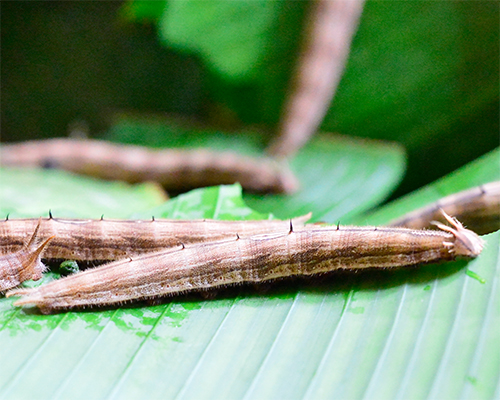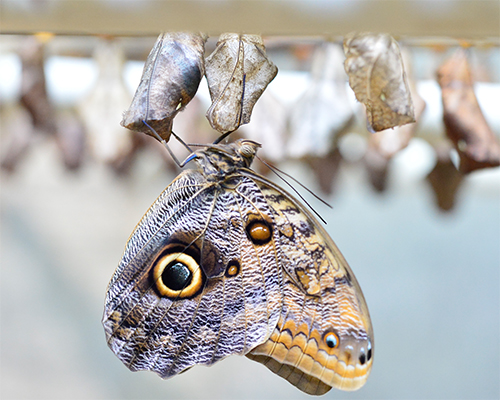Metamorphosis of a Caterpillar to a Butterfly

Evolution says it takes millions of years to change one species into another.
But the Creator does it in just two weeks.

The insect pictured above began life as a caterpillar walking upon numerous legs. It was later transformed into an entirely different insect with the wings of a butterfly. This transformation is called metamorphosis.
How does evolution explain the metamorphosis from a caterpillar to a butterfly?
The advocates of evolution explain this insect and its metamorphosis generally as follows:
"... [the development of] a nymph stage aided their survival [as a caterpillar] and it was added to their life cycle. Eventually at some point a nymph formed a cocoon around itself before maturing to the adult stage. This enabled it to survive a winter and emerge full grown. So, by a long step by step process, the Complete Metamorphosis cycle did arise. This is not absolutely proven." Donning, Daryl P. "Metamorphosis and Evolution." NCSE Reports 14(2) 11. Quoted by Association for Rational Thought.
There is simply no evidence to support this statement -- and none has been offered. It is pure conjecture. Where is a credible, thorough explanation that is something more than the fertile imagination of a Darwinist?
Looking beyond the vague generalizations of larvae becoming caterpillars and learning to weave cocoons and become butterflies, let us look deeper. What has to happen to the caterpillar pictured above in order for it to metamorphose into butterfly? It has to create a way to grow wings and then grow them; it has to create a method to grow the joints that are appropriate for the wings; it has to originate a skeletal structure that previously did not exist; it must construct a different digestive tract that no longer ingests leaves, but nectar from flowers; it has to wholly eliminate its mouth and replace it with a snout that it can roll up and draw from the flowers; it has to create a mechanism to eliminate all of its numerous tiny legs (as well as all of the nerves that coordinate their use) and in their place insert 4 larger legs with their respective muscles, joints and nerves; it must construct and install an entirely different muscular system, different instincts, the hard-wired ability to fly, to navigate, to recognize food, to mate and entirely new nerve fibers must be installed to connect the muscles with the brain of the new butterfly. It needs new feet, a new antenna and all of the sensory perception that it entails -- as well as algorithms to interpret the code that is sent through nerves from the sensory organs to the brain.
Where is the discussion of how a bug developed the ability to create all of these things?
Now take a step deeper.
Evolutionists have written very little about how the brain in insects evolved. The concept of insects' brains has been relegated to words like "primitive" and "simple." This is not rational thought; it is unenlightened, uneducated and untrained thought -- imaginary thought spouted by those who will never for any reason whatever take no for an answer.
The truth is that the brains of these insects are complex beyond comprehension. Other than pure Darwinist conjecture, the theory of random beneficial mutations and survival of the fittest cannot hope to explain how the brain of the butterfly and the brain of the moth or a fly could have possibly evolved.
The brains of "simple" insects such as butterflies, bees and flies are smaller that the head of a pin yet they are hardwired electrical computers that rival the speed and accuracy of a supercomputer. They compute at the rate of a billion computations in 1/1000 of a second. That is a trillion logically organized computations in one second. Organic supercomputers the size of pinheads create vision by processing electrical code, a process of a series of planned, logical steps, each one organized and in place, each one leading to the next and each one lasting 1/1,000,000,000,000 of a second.
"Using the criterion of joules per operation, the brain [of the honeybee] is about 7 or 8 orders of magnitude more power efficient than the best of the silicon chips. A direct consequence of their efficiency is that brains can perform many more operations per second than even the newest supercomputers. The fastest digital computers are capable of around 109 computations per second; the brain of the common housefly, for example, performs about 1011 operations per second when merely resting."
Sejnowski, T.J. and Churchland, P.S. The Computational Brain (MIT Press, 1992), p. 9 (emphasis in the original). Sejnowski and Churchland are well recognized in the field of neurobiology and computational neuroscience and are professors at the University of California. See also Sejnowski, T.J. and Churchland, P.S., 1992. Author's note: a simple internet search provides information relating to the credentials of Terrence J. Sejnowski and P.S. Churchland.
How does evolution explain this? Accidental incremental changes moved the insect up and up, and random genetic changes and dying animals altered the wiring and the programming in the tiny brain and added speed and accuracy. With each new computational cycle produced by each successive generation enable the generation to survive to the prejudice of others. This went on until there was a living fully functional supercomputer smaller than a pinhead that would compute at a trillion fully integrated cycles per second pursuant to detailed hard-wired programs that create vision, awareness and thought.
All of these minute electrical computations - and their hard-wired programs consisting of pure logic - were allegedly designed by random genetic mutations and environmental stresses and dying animals (natural selection).
It is not rational thought to conclude that unobserved mutations and survival of the fittest caused caterpillars to turn into butterflies -- and endowed them with supercomputers the size of pinheads.
The reality is that unless one presumes ab initio that there is no Creator, then it is clearly more rational to conclude that both the caterpillar and the butterfly were designed. They were created. One does not logically conclude that crawling caterpillars change themselves into flying butterflies by accident unless one has already determined in advance that accidents are going to be the only explanation no matter what ... because, well, the other explanation is, you know, religious, and therefore cannot be considered.
When the effects of a cause are clear, it is unscientific to deny the existence of that cause simply because the cause itself has not yet been observed.